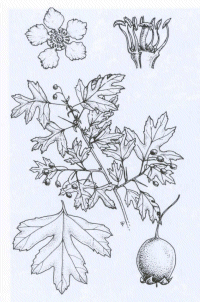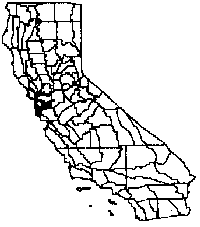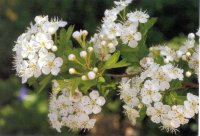|
Crataegus monogyna
|
|
|
|
Scientific name
|
Crataegus monogyna
|
|
Additional name information:
|
Jacq.
|
|
Common name
|
single-seed hawthorn, whitethorn
|
|
Synonymous scientific names
|
Mespilus monogyna
|
|
Closely related California natives
|
Crataegus douglasii, C. suksdorfii
|
|
Closely related California non-natives:
|
0
|
|
Listed
|
CalEPPC Red Alert,CDFA nl
|
|
By:
|
Edward Alverson,Jake Sigg
|
|
Distribution
|
|
|
HOW DO I RECOGNIZE IT?
Distinctive features:
|
Single-seed hawthorn (Crataegus
monogyna) is a deciduous shrub or small tree to twenty feet, with clusters
of white flowers in mid-spring, small red berries in autumn, lasting to late
winter. The small leaves are divided into three to seven lobes. The branches
have stout spines, and the trunk has pale gray, smooth bark. It is usually found
in forest understory. The plant has many garden forms and is capable of
hybridizing with other species of Crataegus, including the native C.
douglasii (Love and Feigen 1978); thus variation in characters is possible
with hybridizing populations.
åÊ
|
|
Description:
|
| Rosaceae. Shrub or small tree up to 20 ft (6 m) tall. Stems: with straight, stout spines on branches. Leaves: 0.6-1.5 in (1.5-3.5 cm) on slender petioles, alternate on stem, ovate to obovate, 3-7-lobed, margins entire or sparingly serrate, smooth except for patches of hairs in axils of veins on the underside. Flowers: flat-topped clusters of many white (fading to pink) blossoms, petals 5, styles 1. Fruit: 0.5 in (1.25 cm) wide red berries, each with a single seed. Pacific Coast native hawthorn species bear purple-black fruit, but hybrids between natives and red-fruited Crataegus monogyna are also purple-black. Flowers of native plants have 5 styles and leaves are mostly unlobed; C. monogyna has a single style and prominently lobed leaves. Hybrids tend to have intermediate characters, 2-3 styles being usual (Bailey 1928; Willis 1973). |

crataegus-illus
|
|
|
|
WHERE WOULD I FIND IT?
|
Incipient populations of single-seed
hawthorn have been found on San Bruno Mountain, in the San Francisco Water
DepartmentÛªs Crystal Springs Watershed (both in San Mateo County), and in
eastern parts of the San Francisco Bay Area. It is well established in parts of
the maritime Pacific Northwest and is a common invasive species in prairies and
deciduous woodlands in the Willamette Valley, Oregon, where it has been present
for over 100 years. Lack of reporting likely accounts for the apparent
distribution gap between San Francisco Bay and the Pacific Northwest.
Single-seed hawthorn grows best in humid or subhumid temperate
regions and does well on most soil types, including shallow, stony soils.
Riparian areas, abandoned fields and pastures, oak woodlands, and other forested
habitats from central California to Alaska must be considered potential habitat.
Vigilance in spotting new infestations would be especially rewarding for
controlling this plant, with its capability for long-range seed dispersal.
Although forests are prime habitats, outlying plants of single-seed hawthorn can
be found in shrubland or grassland, especially near the coast.
åÊ
|
|
WHERE DID IT COME FROM AND HOW IS IT SPREAD?
|
Single-seed hawthorn is indigenous to
Europe and from North Africa to the Himalaya. It was introduced to gardens of
North America (including the West Coast) from England and has been sold here
since the 1800s. Fruit-eating birds are the primary agents of seed dispersal,
and since they typically spend much of their time perched in trees and on fence
posts, the forest understory and along fencerows are where seedlings, young
plants, and older infestations are usually found. The berries are more
attractive to some native birds such as American robins than are native
hawthorns that grow in the same place (Sallabanks 1992, 1993). Seeds may also
spread by clinging to farm machinery, vehicles, and animals or by contaminating
agricultural produce. Fruit-eating mammals may also spread seed.
åÊ
|
|
WHAT PROBLEMS DOES IT CAUSE?
|
Single-seed hawthorn displaces native
plants, and dense thickets alter the structure of the forest understory and make
movement of large animals difficult. Some species of Crataegus contain
hydrocyanic acid in the leaves, which is poisonous to cattle. However, the
presence of this toxin in single-seed hawthorn is currently unknown (Parsons
1992). Birds may prefer its berries to those of native berried plants, including
native hawthorn, and this may lead to local extirpation of the latter.
Single-seed hawthorn has only recently been reported as a
wildland weed in California, and it is not included in The Jepson Manual of
1993. Its rateåÊof spread and degree of threat has not been quantitatively
established, but every indication is that it is a plant to be taken seriously.
One nature preserve in OregonÛªs Willamette Valley has had to be abandoned
because the hawthorn is beyond control of the available resources.
åÊ
|
|
HOW DOES IT GROW AND REPRODUCE?
|
Single-seed hawthorn reproduces by seed, which is primarily dispersed by birds. Flowering occurs in spring. When pollinators are excluded, flowers do not develop fruits (Love and Feigen 1978). Single-seed hawthorn is a prolific fruit producer. At one site in western Oregon, the fruit crop was estimated at 2,721 fruits per plant. Seed longevity is unknown. Seed germination is aided by passing through a birdÛªs digestive tract, but this is not necessary for germination.
|
Germination occurs in spring. Most vegetative growth occurs in spring and early summer, and normal growth rate is one to two feet a year. In the forest plants will shed lower branches and become tree-like, but in the open they will retain branches to ground level. The presence of single-seed hawthorn in forests indicates tolerance of shade and cool temperatures, but it will fruit more heavily if exposed to stronger light.
|
(click on photos to view larger image)
|
Like most shrubs of the rose family, it has
a tenacious root system, although probably not a deep one. Once established,
single-seed hawthorn can withstand moderate drought. Established plants are
capable of stump sprouting when cut or injured.
|
|
Physical control:
|
Manual methods: Small infestations of young
plants can be hand pulled or weed-wrenched out. The best time to cut plants is
in early summer. At this time most of the plantÛªs energy is in the growing tips
and little is stored in the roots. Regrowth occurs unless the entire crown and
the top few centimeters of the main roots are removed.
åÊ
|
|
Biological control:
|
Insects and fungi: This species has no
known effective biocontrol agents. In the British Isles, single-seed hawthorn is
an important host of the fireblight bacterium, which also affects pears and
apples. In some seasons in Australia, plants are severely attacked by the pear
and cherry slug (Caliroa cerasi), which damages the foliage without any
permanent effect on the plant (Parsons 1992).
Grazing: The spines deter
grazing animals, and the plant is regarded as an impenetrable barrier to
grazing.
åÊ
|
|
Chemical control:
|
Larger plants can be cut to the ground and
painted with a solution of 25 percent triclopyr (as Garlon 4) and 75 percent
cottonseed or other light cooking oil as surfactant and inert ingredient.
Glyphosate (Roundup at label-recommended strength) may be substituted for
triclopyr, but results are less certain. A 2 to 3 percent solution of triclopyr
or glyphosate has been sprayed on the foliage for control, but overall spraying
has not generally been reliable and is more likely to affect non-target species
than is painting with herbicide.
åÊ
|




